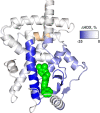Discovery by Virtual Screening of an Inhibitor of CDK5-Mediated PPARγ Phosphorylation
- PMID: 35450368
- PMCID: PMC9014497
- DOI: 10.1021/acsmedchemlett.1c00715
Discovery by Virtual Screening of an Inhibitor of CDK5-Mediated PPARγ Phosphorylation
Abstract
Thiazolidinedione PPARγ agonists such as rosiglitazone and pioglitazone are effective antidiabetic drugs, but side effects have limited their use. It has been posited that their positive antidiabetic effects are mainly mediated by the inhibition of the CDK5-mediated Ser273 phosphorylation of PPARγ, whereas the side effects are linked to classical PPARγ agonism. Thus compounds that inhibit PPARγ Ser273 phosphorylation but lack classical PPARγ agonism have been sought as safer antidiabetic therapies. Herein we report the discovery by virtual screening of 10, which is a potent PPARγ binder and in vitro inhibitor of the CDK5-mediated phosphorylation of PPARγ Ser273 and displays negligible PPARγ agonism in a reporter gene assay. The pharmacokinetic properties of 10 are compatible with oral dosing, enabling preclinical in vivo testing, and a 7 day treatment demonstrated an improvement in insulin sensitivity in the ob/ob diabetic mouse model.
© 2022 American Chemical Society.
Conflict of interest statement
The authors declare the following competing financial interest(s): All authors were employees of AstraZeneca and may have held AZ stock at the time the work was performed.
Figures







References
-
- Lehmann J. M.; Moore L. B.; Smith-Oliver T. A.; Wilkison W. O.; Willson T. M.; Kliewer S. A. An antidiabetic thiazolidinedione is a high affinity ligand for peroxisome proliferator-activated receptor gamma (PPAR gamma). J. Biol. Chem. 1995, 270 (22), 12953–12956. 10.1074/jbc.270.22.12953. - DOI - PubMed
LinkOut - more resources
Full Text Sources
Chemical Information
Molecular Biology Databases
Miscellaneous

